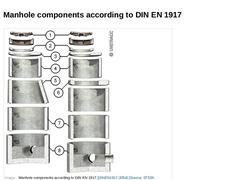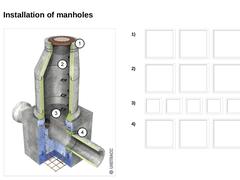
|

This lecture is part of the lecture series "Trenchless 101" and gives an introduction to the topic of trenchless construction and rehabilitation methods. (Image: Trenchless 101) |

|

| (Image: Overview of the present underground infrastructures)
|
|

|

The type, quantity and distribution of the lines found in the street cross section are primarily dependent on the locality-specific conditions such as street width, drainage procedure, installations and structures. (Image: Overview of typical inner-city line types) (Video: Supply and disposal piping in street cross section) |
|

|

| (Image: Infrastructures in the urban underground [FI-Steina])
|
|

|

|
Advantages of trenchless technology compared to the open cut method: - Preventing break-up and replacement of road surface
- Prevention of soil excavation masses
- Minimizing groundwater retention measures
- Little impairment to traffic flow especially in inner urban areas
- Only short-term noise and emission pollution while excavating the starting and target shafts
| |
(Image: Disadvantages of the open cut method for installing drains and sewers (Part 1) [GSTT])
|
|
|

|

| (Image: Documentation)
|
Piping documentation conforming to reality is usually not available, even the owners of the pipe network often have no accurate knowledge of the position of their pipelines. This means that one cannot assume the existence of a distribution according to the standards in the underground construction space. | |
(Image: Underground pipelines in New York about 1916 [Boegl69])
|
(Image: Unprofessional installed cables and pipelines [… |
|
|

|

| New installation (Image: New installation)
All variants of the underground installation of lines by means of pulling-in, pushing-in, pressing-in or ramming-in into a cavity (borehole) made in the soil by means of boring or drilling. | Rehabilitation (Image: Rehabilitation)
All measures for restoring or upgrading the performance of existing drain and sewer systems. |
|

|

|

|

This lecture is part of the series "Trenchless 101" and serves to provide an overview of trenchless methods for the new installation and rehabilitation of supply and disposal lines. |

|

This lecture "Rehabilitation" is part of the lecture series "Trenchless 101" and serves to provide an overview of the rehabilitation process of supply and disposal lines. Further individual lectures of this lecture series will separately present and discuss the main process groups repair, renovation and replacement. |

|

| (Image: Rehabilitation)
According to EN 752-1 [DINEN752-1] rehabilitation is understood to be: All measures for restoring or upgrading the performance of existing drain and sewer systems. |
|

|

| |
According to EN 752 [EN752:2008] "in principle the performance requirements for a rehabilitated system shall be the same as those for a new system". | In the following, examples in which this requirement was not realized: |
(Image: Liner - Insufficient internal pressure / hardened too early / influence of groundwater)
|
(Image: Folds in a cured in place pipe)
|
(Image: Folds in a cured in place pipe)
|
(Image: Buckled stainless steel sleeve)
|
|
|

|

|

|

|

|

| (Image: General structure of a drain and sewer system)
|
|

|

|
Section: A section between two manholes and/or special constructions. (Image: Principle sketch of a section)
|
|

|

| (Image: Manholes)
|
Manhole to EN 752: chamber with a removable cover constructed on a drain or sewer to permit entry by personnel [EN752:2008].
|
|

|

| (Image: Manhole components according to DIN EN 1917 [DINEN1917a] [Image: S&P GmbH]) |
|

|

| (Image: Structure of a manhole)
| |
(Image: Underfilling the frame of the manhole top with mastic asphalt)
|
(Image: Vertically adjustable manhole top with spring element)
|
(Image: Cross section of a manhole top when embedded into the carrier layer and paved with specifically shaped stones with reference to [FI-Schwab] [Image: S&P GmbH])
|
1) | |
(Image: View into the cleaned starting manhole)
|
(Image: View into the opened manhole)
|
(Image: Climbing … |
|
|

|

|
(Image: Street cross section wih combined system)
|
|
(Image: Street cross section with separate system)
|
|
With regard to drainage methods, i.e. the "discharge type of sewage" [DIN4045:2003], the following distinctions can be drawn: Combined system:
Drain and sewer system designed to carry both foul wastewater and surface water in the same pipeline(s) [EN752:2008]. Separate system:
Drain and sewer system, usually of two pipelines, one carrying foul wastewater … |
|

|

|

|

|
The possible attempts at solutions can consist of hydraulic, environmentally relevant or structural aspects and achieve improvements in one or more of these fields [DINEN752-5:1997]. | Environmentally relevant effects (Image: Environmentally relevant)
| Hydraulic
effects (Image: Hydraulic)
| Structural
effects (Image: Structural)
|
|

|

| (Image: Structural)
Particular emphasis will be placed in the following on the structural solutions (also called structural rehabilitation). According to EN 752-5 [DINEN752-5:1997] they comprise: - Protection of the sewer substance by means of suitable linings or inner coatings
- Rehabilitation of the sewer substance by means of:
- Repair
- Renovation
- Replacement.
| Repair (Image: Repair)
| Renovation (Image: Renovation)
| Replacement (Image: Replacement by trenchless … |
|

|

|
The processes belonging to the rehabilitation of the sewer substance for structural rehabilitation comprises several main groups of processes with numerous special processes (Bild null). (Image: Overview of the main processing groups for the structural rehabilitation of drain and sewer systems)
|
|

|

| (Image: Attention!)
As description of damage, its extent and its cause as well as the piping-specific limiting conditions in sewer systems are so different, the correct selection of the respective application case and the applicable structural rehabilitation measures are of great importance [Stein89c] [Stein95f]. | | | (Image: Pros and cons)
All repair, renovation and replacement processes have advantages and disadvantages as well as limitations for their … |
|